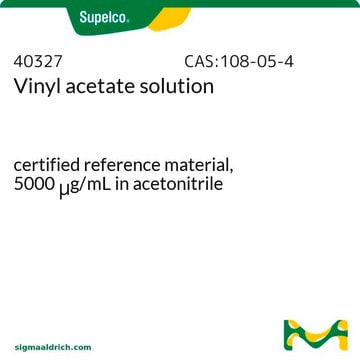48486
Vinyl acetate
analytical standard
Synonyme(s) :
Acetoxyethylene
About This Item
Produits recommandés
Qualité
analytical standard
Agence
EPA 8240,8260
Densité de vapeur
3 (vs air)
Pression de vapeur
88 mmHg ( 20 °C)
CofA (certificat d'analyse)
current certificate can be downloaded
Température d'inflammation spontanée
801 °F
Limite d'explosivité
13.4 %
Conditionnement
pkg of 1000 mg
Technique(s)
HPLC: suitable
gas chromatography (GC): suitable
Indice de réfraction
n20/D 1.395 (lit.)
Point d'ébullition
72-73 °C (lit.)
Pf
−93 °C (lit.)
Densité
0.934 g/mL at 25 °C (lit.)
Application(s)
cleaning products
cosmetics
environmental
food and beverages
personal care
petroleum
Format
neat
Température de stockage
2-8°C
Chaîne SMILES
CC(=O)OC=C
InChI
1S/C4H6O2/c1-3-6-4(2)5/h3H,1H2,2H3
Clé InChI
XTXRWKRVRITETP-UHFFFAOYSA-N
Vous recherchez des produits similaires ? Visite Guide de comparaison des produits
Description générale
Application
Autres remarques
Mention d'avertissement
Danger
Mentions de danger
Conseils de prudence
Classification des risques
Acute Tox. 4 Inhalation - Aquatic Chronic 3 - Carc. 2 - Flam. Liq. 2 - STOT SE 3
Organes cibles
Respiratory system
Code de la classe de stockage
3 - Flammable liquids
Classe de danger pour l'eau (WGK)
WGK 2
Point d'éclair (°F)
17.6 °F - closed cup
Point d'éclair (°C)
-8 °C - closed cup
Équipement de protection individuelle
Eyeshields, Faceshields, Gloves, type ABEK (EN14387) respirator filter
Choose from one of the most recent versions:
Déjà en possession de ce produit ?
Retrouvez la documentation relative aux produits que vous avez récemment achetés dans la Bibliothèque de documents.
Les clients ont également consulté
Notre équipe de scientifiques dispose d'une expérience dans tous les secteurs de la recherche, notamment en sciences de la vie, science des matériaux, synthèse chimique, chromatographie, analyse et dans de nombreux autres domaines..
Contacter notre Service technique
















